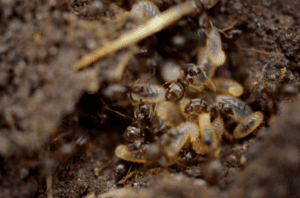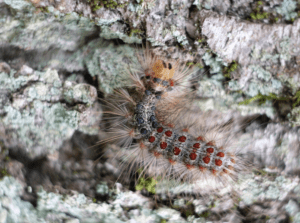

Clothes moths have been ruining people’s favorite sweaters for centuries. Even Shakespeare wrote about their treachery! Despite the species’ age, though, their habits are still a mystery to many. To help remedy this, we put together the following guide to clothes moths.
What kinds of moths eat clothes?
Technically, moths don’t eat clothes. In fact, most moths eat nothing at all throughout adulthood. Their larvae, who have not quite reached the “moth” stage of their life cycle, are the real clothing culprits. There are two moth species in the U.S. whose larvae eat clothes- the casemaking clothes moth, which is brownish-gray with dark spots, and the webbing clothes moth, which is goldish-tan. Larvae and adults of both species are roughly ½ inch in length, and larvae are cream-colored with a brown head. Adult clothes moths lay their eggs on or in fabrics so that when they hatch, the larvae have plenty of food to eat until they reach adulthood. Webbing clothes moth larvae make little tunnels out of excrement and the fibers around them. They travel through these tunnels to feed. Casemaking clothes moth larvae make little cocoon-like cases that they carry with them wherever they go. The cases are made out of the same materials as the tunnels and they grow with the larvae.Why do moths eat clothes?
The larvae of clothes moths get their nutrients from natural fibers, especially animal by-products. They are partial to keratin in particular as a nutrient source, and most animal-based fabrics have a high keratin content. Keratin can also be found in human hair, skin, and nails, particles of which get left on clothing. So, what kinds of fabrics do clothes moth larvae eat? Well, they love to munch on animal-based fabrics like wool, silk, fur, and feathers, but they will also eat plant-based materials like cotton, linen, and hemp. Clothes moths do not exclusively eat clothes. They will eat anything made from the materials above including carpets, rugs, drapes, upholstery, bed sheets, and more.What attracts clothes moths?
Clothes moths are naturally attracted to the fabrics they like to eat, but they will not settle into just any pile of clothes. They seek out materials that meet certain conditions. Clothes moths stay away from fabrics that are used or washed regularly. Fabrics that go undisturbed for long periods are far more attractive to them. Unwashed clothes are at a higher risk for moth damage than clean ones because they are more likely to have skin cells or hair on them, consequently making them more nutritious for larvae. The environment in which the fabrics are stored also plays a role in infestations. Clothes moths are attracted to darkness, unlike other moth species who flock to light sources. For this reason, they are most often found in closets, wardrobes, chests, and attics. Attics may be especially vulnerable to infestations because they are often prone to humidity, another quality that clothes moths love.Signs of Clothes Moths
Next time you’re going through your stored clothes, keep an eye out for these signs of clothes moth activity:- Eggs, which look like tiny grains of rice. They are roughly the size of a pinhead and are creamy white in color.
- Larvae, as described earlier, are cream-colored with brown heads. They very much resemble maggots.
- Adult Clothes Moths hanging around in dark spaces or flying out of a closet when it is opened. They are not the ones that do the damage, but their presence means that there are probably larvae nearby.
- Tunnels and cases built by larvae. They are usually the same color as the fibers of the fabric the larva is eating through.
- Holes in fabrics that were not there before. The more holes there are, the worse the infestation is. In extreme cases, carpets and rugs may even have threadbare patches. Note: Holes are a good indication of clothes moths, but not a definitive one; there are other pests, like carpet beetles, that also eat fabric.






